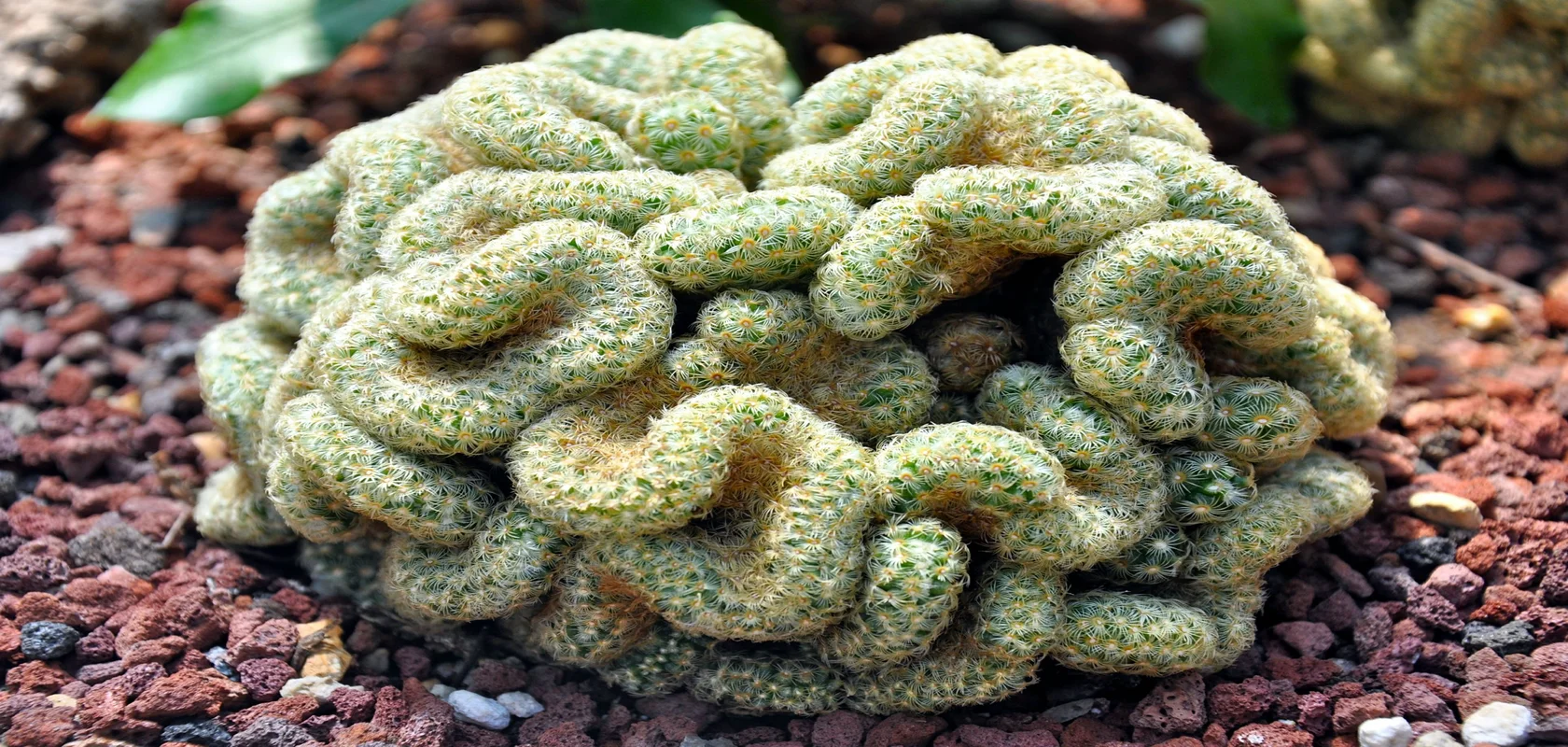The Brain Cactus belongs to the region of Central Mexico and the family of Mammillaria Elongata. This is the reason why this cactus is sometimes also referred to as the Mammillaria Elongata Cristata.
The name brain cactus is because of its convoluted and sinuous growth, somewhat like a peculiar crest. Let me tell you a very interesting fact about its shape. The brain cactus skull is formed as a result of the damages that happen to the plant when at its tender age.
Like other succulents, the brain cactus has a peculiar center of growth which is known as the apical meristem.
The Mammillaria Elongata cactus is also sometimes referred to as the Ladyfingers cactus. The pattern of the growth is quite similar to the structure of a worm, some say it is like that of a brain and that is how the plant got the nickname brain cactus.
How to Identify

Some wavy ribbing structures are present on the surface of the plant which makes its appearance look like a brain cactus skull. Another amazing fact about this cactus is that no two brain cactus plant will have type same shape or ribs which makes each one of them unique.
This cactus that looks like broccoli attains only a height of about 6 inches and with a width of 12 inches makes the cactus look quite chubby in its appearance.
The succulent has a globular shape and is available in shades of grey-green, sometimes deep green even. The spines although are quite different in coloration have a brownish shade.
The spring season is the ideal time for planting a brain cactus as the growth rate is quite slow. The growth develops a bit if the climatic conditions are warmer and the cactus will grow like any other houseplant.
Are Ladyfingers Cactus and Brain Cactus same?

The answer is yes, ladyfinger and brain cactus are the same plant. Then, the question arises, why do they look different?
The answer lies in the amazing phenomenon of the plant world. It actually happened through mutation or damage.
During the initial growth phase of the cactus and succulent plant, they have some tissue known as meristematic tissue or ‘growing tip’. The main function of this tissue is to set off new cells growth in young seedlings at the tips of the shoots and form buds.
By any means, if these tissues are damaged by an insect or a natural mutation, the crest becomes deformed and shapes as a structure of the brain. Isn’t it amazing? Nature beautifies itself.
Brain Cactus Types
The brain cactus scientific name is Stenocactus multicostatus. There are several species in the Stenocactus some of which are discussed below.
- Stenocactus crispatus – It has dark green ribbing, long spines, and pale violet flowers.
- Stenocactus phyllacanthus – It produces small yellow flowers and has stiff, tan spines.
- Stenocactus coptonogonus – This species has straight ribbing and blooms with white flowers that have lavender stripes.
Let us now learn about some of the types of brain cactus available in the market.
Euphorbia brain cactus
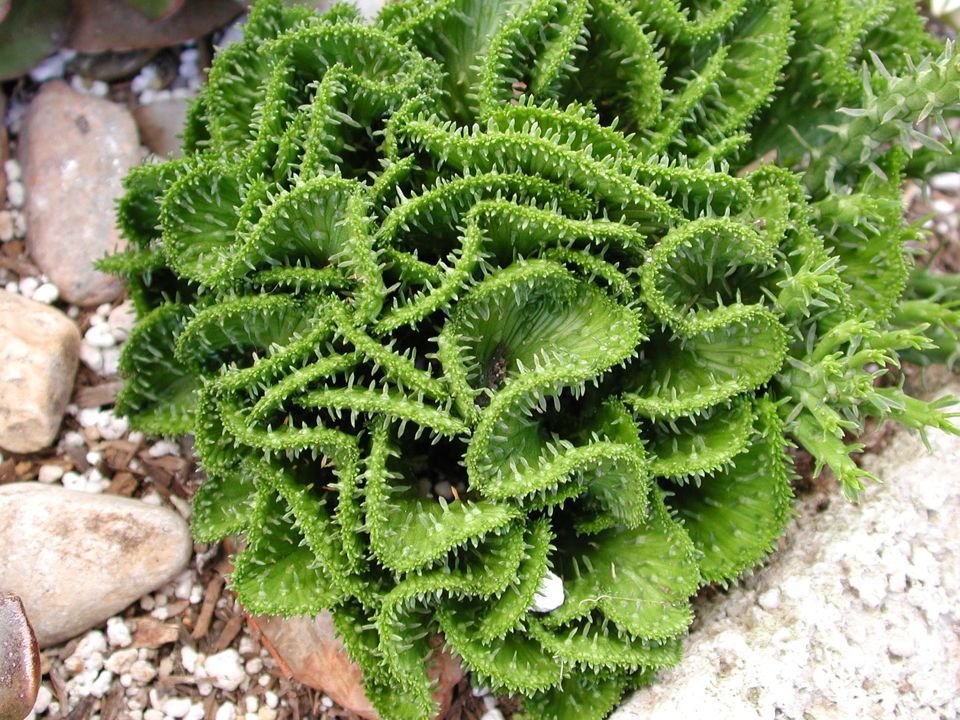
A succulent with a lot of branches and numerous small spines, the Euphorbia cactus is a succulent that grows up to 5 cm in height and has a width of 30 cm.
The central stem merges into roots forming a tuberous body which is sometimes referred to as the caudex. Looking at the large specimen you might feel it to be a sunflower but actually is another example of a Fibonacci spiral.
Cristata brain cactus
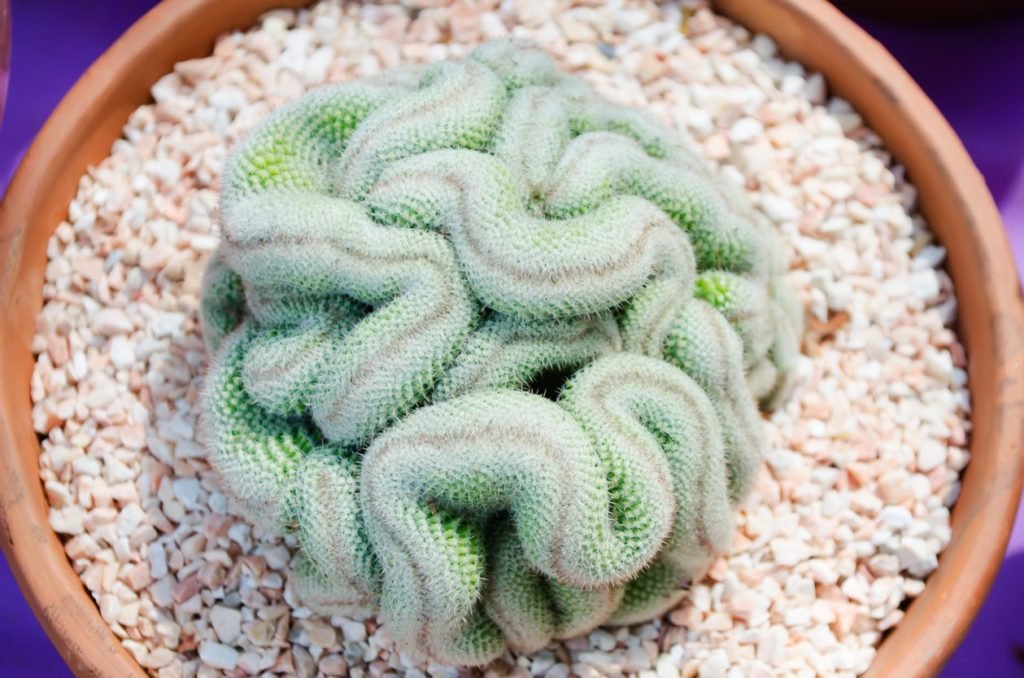
Another form of this species that is referred to as a brain cactus is the Cristata cactus. This cactus has very small flowers which makes them a very good choice as houseplants.
They can also be grown in outdoor gardens in warmer climates.
Medusa brain cactus

This cactus has its homeland in South Africa and can grow up to a height of 3 feet.
The blooms of the Medusa brain cactus are yellowish-green in appearance and tend to flourish during the spring and late summer.
This cactus has several grey-colored snake-like branches which also hold a greenish hue. The branches extend are leafless and arising from the central hub. They have a twisty appearance and are filled with nutrients and moisture.
Coral brain cactus
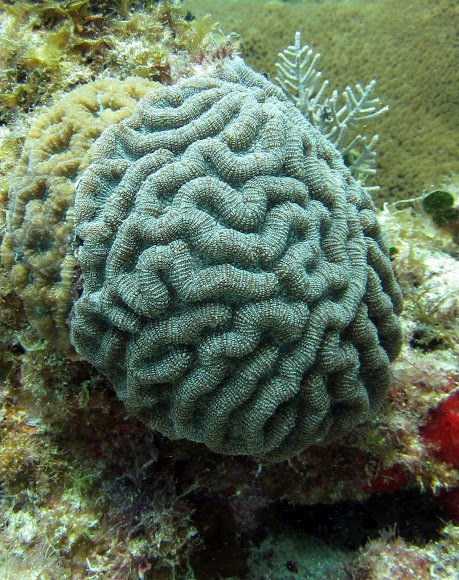
A cactus native to the African sub-continent and belonging to the Euphorbia genus & Euphorbiaceae family, the brain coral cactus is a result of mutation from two different plants of the same species. The name is because of this cactus that looks like coral.
This plant does not demand a lot of attention and therefore is favored by indoor gardeners. The watering routine is simple and does not require to be re-potted regularly.
The plant grows nearly about 9 – 15 inches and is poisonous in nature.
Where can I buy a brain cactus?
There are plenty of websites from where you can purchase a cactus from. Let me tell you some of the best websites from where you should buy these cacti. Some of the popular websites are enlisted below:
- Amazon
- Etsy
- inLinkz
If you are looking for free shipping offers for a brain cactus, bunnings can be your choice. You can also find these cacti from your nearest local markets.
Caring Routine for the Brain cactus
The caring routine for the brain-looking cactus is not that complicated and all you need to do is keep in mind the basic gardening facts about the brain cactus while you plant it.
Let us quickly begin with the key points now.
Size & Growth
The Brain Cactus is a small plant d and spreads somewhat nearly 12 inches. They are a perfect bonsai material due to their small size.
As you already know, the shape of the cacti is due to the damage in its youth, but amazing thing is that the damage is manually manipulated to enhance its growth.
The injured cells multiply very fast and thus making the pads of the succulent twist giving it the shape of a brain.
Light
To attain the best of its health, the cactus must be placed in full sunlight. The intensity of the sun is preferred by the cacti but it can also do well in a shade if cannot get a complete exposure.
However, it is important to take good care of the plant during the summer season. You cannot afford to keep it exposed to the tremendous heat of the sun for more than 5 hours a day.
If you are not careful enough the cactus will get damaged and may even die. If you are growing it in your interior home garden, make sure you place it in a bright spot to get full sun exposure.
Temperature and Humidity
Warm temperatures are preferred by this cactus and 50ºF is supposed to be an ideal one.
Low humidity levels are alright for the cactus high levels of humidity is dangerous as it may cause excessive moisture retention in the soil causing rot root.
Watering
Water a lot during the summer season but make it less and only when needed during the winters.
Overwatering can kill your plant, so be cautious!
Also, you should not underwater as it will definitely make the brain cactus wilt.
Soil Preparation
A soil mixture with well-draining properties is the ideal one for a succulent. You may use a cactus soil mix, or a combination of sand, potting mix, and pumice for preparing the soil for your cactus. A portion of organic matter can be used to provide sufficient minerals to the plant.
Fertilizer
The brain cactus doesn’t require to be fed always and only requires fertilizers during the active growth phase.
A liquid fertilizer halved to its strength by adding water can be used to enhance the growth of your cacti plant.
Diseases and Pest Control
The best thing about a cactus is that they would not get diseases because you lacked caring. But still, there are some diseases that affect every cactus plant.
Let me notify some of them so that you can take early precautions to avoid these diseases.
- Sunburn – Due to excessive exposure to direct sunlight.
- Desiccation – Due to lack of watering.
- Frost Damage – Due to freezing temperature.
- Corking – Cactus turned brown due to the dryness and harsh sunlight.
Sometimes gardeners also witness damages from insects in the apical meristem which may cause a cell mutation, but it’s rare.
If you find a brain cactus dying, there may be numerous problems like environmental conditions, fungus, bugs, and some diseases. However, if you care well, the diseases can be avoided.
This species of cactus is sensitive to red spiders. Aphids, Caterpillars, Nematodes, Slugs, and snails are also some pests that can affect your brain cactus.
You can use natural insecticides like neem oil to prevent them.
Potting and Re-potting
You do not require a big container as the roots are shallow and an unglazed pot would be the best for its plantation.
You can use a skull painter with brain cactus that looks quite different. Many may have a different thought but a brain cactus in skull pot is very attractive.
Once you notice roots coming out of the pot, it’s probably time to re-pot the plant. Be gentle while you remove the plant from its existing pot. If you are not careful, you can hurt yourself as an adult cactus has a lot of spines.
Now, place it in the new pot and add some freshly prepared potting mix. Wait for some time before you start watering it. After 1-2 weeks start watering following a definite routine.
Propagation
Do you want to know how to propagate brain cactus? Propagating a brain cactus is something different from other cacti plants due to its crested structure.
A creative approach needs to be made to propagate. Let me guide you through this.
- Start by cutting a portion of the stem, a bit longer in size, with a grafting knife.
- Now, you will find a ring-like thing on both sides of the cut piece. You need to overlap them for propagating.
- You need to layer it on top of an existing brain cactus You can use a rubber band to tie the 2 pieces together and hold them in place.
- After a few months, the pieces will get joined.
You can propagate your Mammillaria Elongata in some other ways as well, but grafting works the best for the propagation of the succulent.
Flowering & Blooming
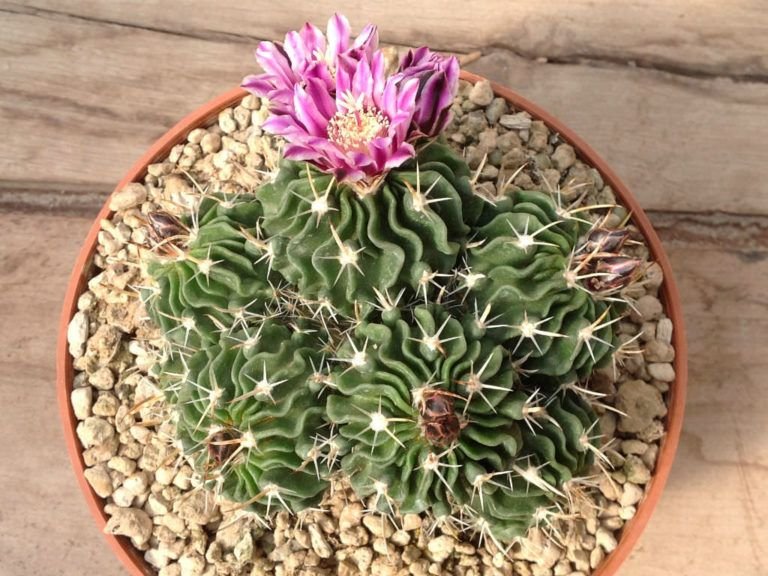
A healthy plant will always flower and the blooming will also be in the appropriate season and time. However, to attain a healthy plant, you need to take good care of the plant.
You must ensure your cactus is getting good light exposure and also kept in a warmer place. The soil needs to good in quality and well-draining. You also need to take special care of the watering routine and do not water during the dormant phase.
The brain cactus flower, also known as the Cockscomb flower is native to India and will be found whole over the world. It is widely planted by gardeners and looks like a brain and rooster’s head.
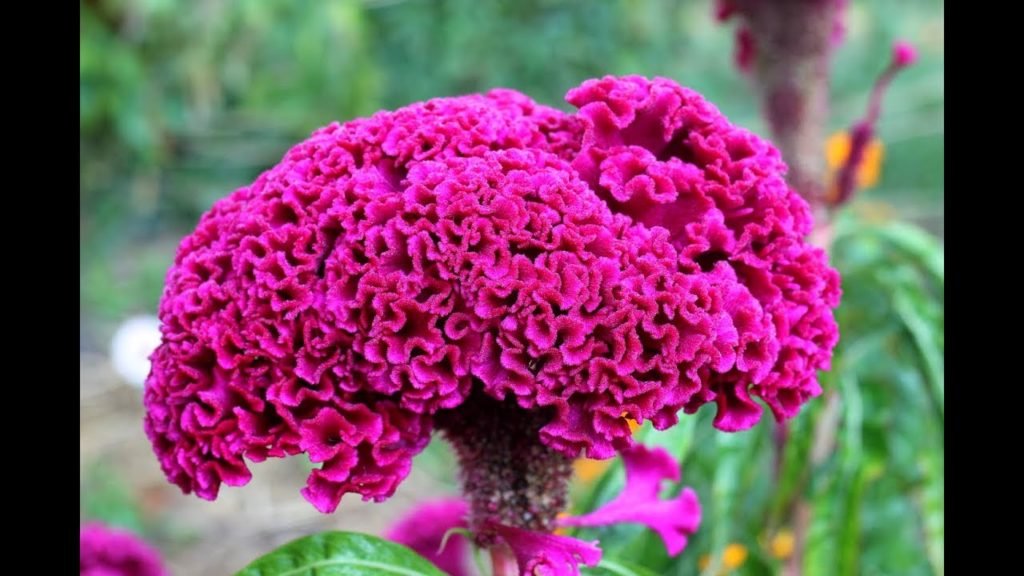
This flower is nice for appreciation in fresh, but also as dry flower bouquets when it’s cut and dried. In countries like India and Africa, its leaves and flower also are used as vegetables.
Toxicity to Pest & Children
The brain cactus can be termed as a poisonous cactus and not safe for children at all. They have sharp spines which can be very dangerous for both pets and children.
If you have one at your home, keep it in a safe place away from the reach of your pet and also away from your children.
Although I do not prefer it, you can also use pet repellent sprays to avoid your pets coming near your cactus. The pets can damage your cactus even.
There are sometimes colonies of bugs growing in a cactus. Avoid your child from touching it as it might cause skin rashes if the bugs come in touch with the child’s skin.
Conclusion
The brain cactus is an ideal choice for your home garden if you are fascinated by unique plants. If you are a newbie gardener and worried about your planting experience, be relaxed as this cactus does not demand much effort in growing.
If you’re a cacti lover looking to add a unique specimen to your collection, the brain cactus is a good selection although you don’t have plenty of space.
This cactus suits any home, but they fit modern interior decors fine, perfectly complementing wood and stone accents.
So, what are you waiting for now that you know everything about the plant? Go ahead and make your brain say ‘Yes’ to buying a brain cactus.
